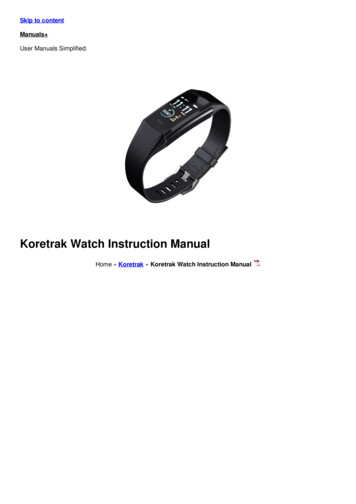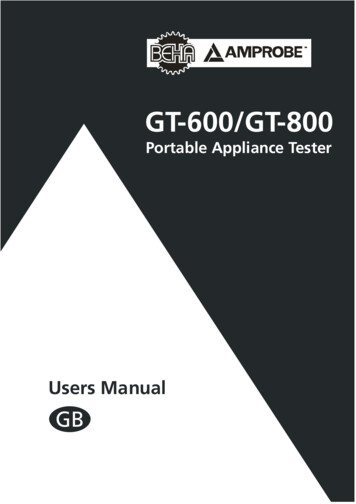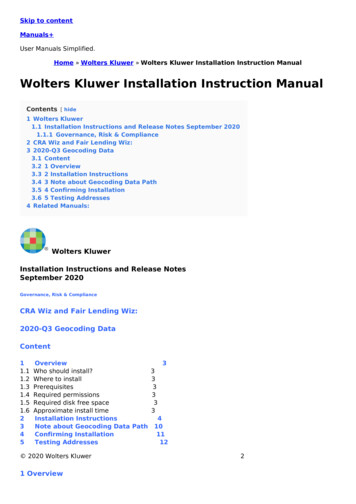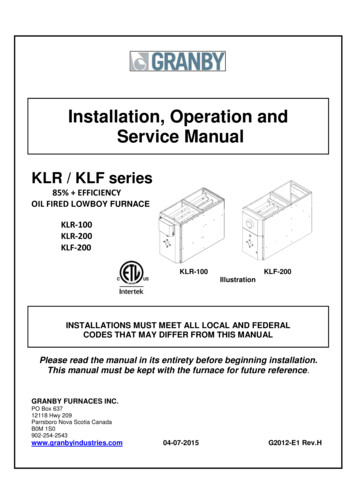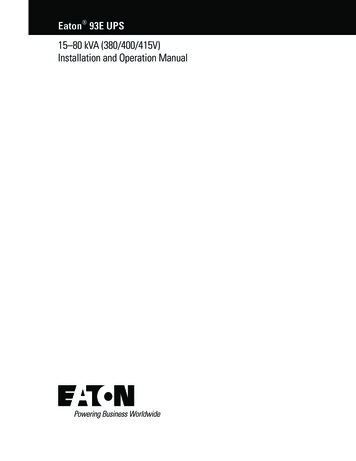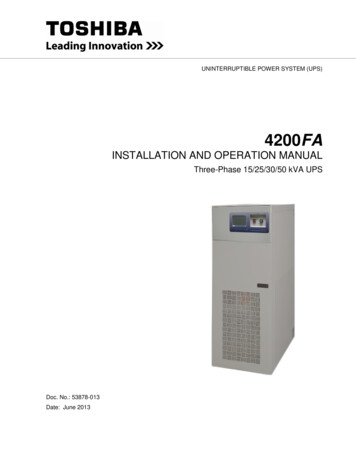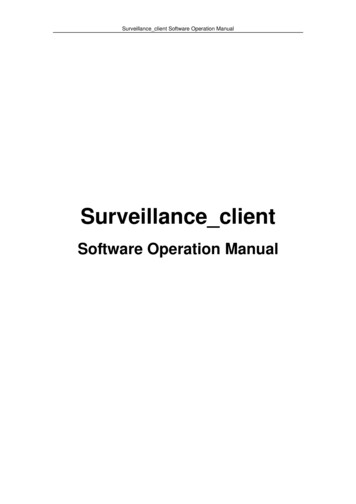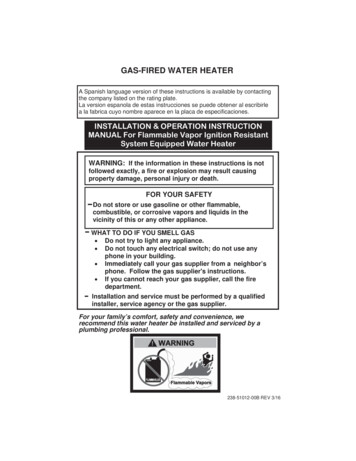
Transcription
GAS-FIRED WATER HEATERA Spanish language version of these instructions is available by contactingthe company listed on the rating plate.La version espanola de estas instrucciones se puede obtener al escribirlea la fabrica cuyo nombre aparece en la placa de especificaciones.INSTALLATION & OPERATION INSTRUCTIONMANUAL For Flammable Vapor Ignition ResistantSystem Equipped Water HeaterWARNING: If the information in these instructions is notfollowed exactly, a fire or explosion may result causingproperty damage, personal injury or death.FOR YOUR SAFETYDo not store or use gasoline or other flammable,combustible, or corrosive vapors and liquids in thevicinity of this or any other appliance.WHAT TO DO IF YOU SMELL GASx Do not try to light any appliance.x Do not touch any electrical switch; do not use anyphone in your building.x Immediately call your gas supplier from a neighbor’sphone. Follow the gas supplier's instructions.x If you cannot reach your gas supplier, call the firedepartment.Installation and service must be performed by a qualifiedinstaller, service agency or the gas supplier.For your family’s comfort, safety and convenience, werecommend this water heater be installed and serviced by aplumbing professional.238-51012-00B REV 3/16
CONGRATULATIONS!You have just purchased one of the finest water heaters on the markettoday!This installation, operation and instruction manual will explain in detailthe installation and maintenance of your new Flammable Vapor IgnitionResistant Gas Water Heater. We strongly recommend that you contact aplumbing professional for the installation of this water heater.We require that you carefully read this manual, as well as the enclosedwarranty, and refer to it when questions arise. If you have any specificquestions concerning your warranty, please consult the plumbingprofessional from whom your water heater was purchased. For yourrecords we recommend that you write the model, serial number andinstallation date of your water heater in the maintenance section in theback of this manual.This manual should be kept with the water heater.Special Flammable Vapor Ignition Resistant System:This water heater is equipped with a Flammable Vapor Ignition Resistant System.In the event of improper usage or storage of gasoline or other flammable materialsin the location where the water heater is installed, the technology will resist ignitionof the flammable vapors outside the confines of the water heater.The Flammable Vapor Ignition Resistant System features:x Advanced Flame Arrestor Design.x Re-settable Thermal Switch to prevent burner/pilot operation withrestricted airflow.x Piezo Igniterx Sight Window to observe operation of pilot and burner.FOR YOUR SAFETY: Activation of the Flammable Vapor Ignition ResistantSystem occurs when flammable vapors are drawn into the water heater and arecombusted. If flammable vapors are detected:x Do not try to light any appliance.x Do not touch any electrical switch; Do not use any phone in your building.x Leave the premises and immediately call the fire department from aneighbor’s phone. Follow the fire department’s instructions.Once the flammable vapor has been evacuated, contact your plumbingprofessional or the manufacturer for further instructions. Replacement of aFlammable Vapor Ignition Resistant System equipped water heater due to aflammable vapor shutdown is not covered under the terms of the limited warranty.2
TABLE OF CONTENTSGENERAL INFORMATION .page4INSTALLATION .6Locating The Water Heater .6Minimum Clearances .9Venting.10Combustion Air Supply .11Water Connections .13Gas Connections .16GENERAL OPERATION .17Lighting and Shutdown Instructions .18Thermostat Adjustment .20Burner Flame Check .22MAINTENANCE .23TROUBLESHOOTING .26INSTALLATION DRAWING FOR POTABLE WATER .28PARTS LIST DRAWING .29PARTS LIST .30INSTALLATION INSTRUCTIONS FOR POTABLE WATER ANDSPACE HEATING .31NOTES .323
GENERAL INFORMATIONThis gas-fired water heater is design certified by CSA International under theapplicable American National Standard, Z21.10.1 or CSA 4.1-(as indicated onthe rating plate), available from CSA International, 8501 East Pleasant ValleyRoad, Cleveland, OH U.S.A. 44131-5575.This water heater must be installed in accordance with local codes. In theabsence of local codes, it must be installed in compliance with the NationalFuel Gas Code (ANSI Z223.1-Latest Edition), or in Canada CAN/CGA B149.1Natural Gas Installation Code (Latest Edition) or CAN/CGA B149.2 PropaneInstallation Code (Latest Edition). The warranty for this water heater is ineffect only when the water heater is installed, adjusted, and operated inaccordance with these Installation and Operating Instructions. Themanufacturer will not be liable for any damage resulting from alteration and/orfailure to comply with these instructions.This water heater is not design certified for installation in a mobile home.Such an installation may create a hazardous condition and will nullify thewarranty.This water heater has been designed and certified for the purpose of heatingpotable water. The installation and use of this water heater for any purposeother than the heating of potable water may cause damage to the waterheater, create a hazardous condition, and nullify the warranty.CAUTIONIncorrect operation of this appliance may create a hazard to life andproperty and will nullify the warranty.WARNINGPrior to connecting the gas supply line to a gas fired water heater,ensure that the gas supply line does not have moisture/water ordirt/scale inside the gas line. Commonly this check is done at thelowest point in the gas distribution system prior to gas burningappliances.Do not use this appliance if any external part to the tank has been submergedin water. You should contact a qualified service technician to inspect theappliance and to replace any part of the control system including thecombination gas control which has been submerged in water. See the GasConnections section of this manual before servicing or replacing a waterheater that has had any external part to the tank submerged in water.DANGERDo not store or use gasoline or other flammable, combustible, orcorrosive vapors and liquids in the vicinity of this or any otherappliance.4
General Information continued-IMPORTANTBefore proceeding, please inspect the water heater and components forpossible damage. DO NOT install any damaged components. If damageis evident then please contact the supplier where the water heater waspurchased or the manufacturer listed on the rating plate for replacementparts.This water heater has been manufactured for operation at altitudes from sealevel to 2000 feet (610 m) (unless otherwise specified on the water heaterrating plate). For use of this appliance at an elevation greater than 2000 feet(610 m), contact the dealer or manufacturer listed on the rating plate forinformation on any necessary modification. Uncorrected operation of thisappliance may create a hazard to life and property.Make sure that you check the rating plate and combination gas control on thewater heater to be certain that the type of gas being supplied correspondswith the marking on the rating plate and combination gas control.A sacrificial anode(s) is used to extend tank life. Removal of any anode,except for inspection and/or replacement, will nullify the warranty. In areaswhere water is unusually active, an odor may occur at the hot water faucetdue to a reaction between the sacrificial anode and impurities in the water. Ifthis should happen, an alternative anode(s) may be purchased from thesupplier that installed this water heater. This will minimize the odor whileprotecting the tank. Additionally, the water heater should be flushed withappropriate dissolvers to eliminate any bacteria.WARNINGThis product contains one or more chemicals known to the State ofCalifornia to cause cancer, birth defects, or reproductive harm.5
INSTALLATIONLOCATING THE WATER HEATERWARNINGWater heaters are heat producing appliances. To avoid damage orinjury there shall be no materials stored against the water heater orvent-air intake system and proper care shall be taken to avoidunnecessary contact (especially by children) with the water heater andvent-air intake components. UNDER NO CIRCUMSTANCES SHALLFLAMMABLE MATERIALS, SUCH AS GASOLINE OR PAINTTHINNER BE USED OR STORED IN THE VICINITY OF THIS WATERHEATER, VENT-AIR INTAKE SYSTEM OR IN ANY LOCATION FROMWHICH FUMES COULD REACH THE WATER HEATER OR VENTAIR INTAKE SYSTEM.This water heater MUST NOT be installed in any location where gasolineor flammable vapors are likely to be present, unless the installation issuch to eliminate the probable ignition of gasoline or flammable vapors.Water heaters in residential garages must be installed and located, orprotected, to avoid physical damage. For other installations refer tolocal codes. In the absence of local codes, the water heater must beinstalled in compliance with the National Fuel Gas Code, (ANSI Z223.1Latest Edition), or in Canada CAN/CGA B149.1 Natural Gas InstallationCode (Latest Edition) or CAN/CGA B149.2 Propane Installation Code(Latest Edition).The location of this water heater is of the utmost importance. Before installingthis water heater read the Installation section of these instructions. Afterreading these Installation and Operating Instructions, select a location for thewater heater where the floor is level and is easily accessible to gas and watersupply lines. DO NOT locate the water heater where water lines could besubjected to freezing temperatures. Make sure the cold water pipes arenot located directly above the gas control so that condensate duringhumid weather does not drip on the controls.This water heater MUST be installed indoors out of the wind andweather.To comply with NSF requirements this water heater is to be:a) Sealed to the floor with sealant, in a smooth and easily cleanableway, orb) Installed with an optional leg kit that includes legs and/or extensionsthat provide a minimum clearance of 6” beneath the water heater.6
Installation (Locating The Water Heater) continued-Note: For California installation this water heater must be braced,anchored, or strapped to avoid falling or moving during an earthquake.See instructions for correct installation procedures. Instructions may beobtained from DSA Headquarters Office, 1102 Q Street, Suite 5100,Sacramento, CA 95811.Water heater corrosion and component failure can be caused by the heatingand breakdown of airborne chemical vapors. Examples of some typicalcompounds that are potentially corrosive are: spray can propellants, cleaningsolvents, refrigerator and air conditioning refrigerants, swimming poolchemicals, calcium and sodium chloride, waxes and process chemicals.These materials are corrosive at very low concentration levels with little or noodor to reveal their presence. NOTE: DAMAGE TO THE WATER HEATERCAUSED BY EXPOSURE TO CORROSIVE VAPORS IS NOT COVEREDBY THE WARRANTY. DO NOT OPERATE THE WATER HEATER IFEXPOSURE HAS OR WILL OCCUR. DO NOT STORE ANY POTENTIALLYCORROSIVE COMPOUNDS IN THE VICINITY OF THE WATER HEATER.WARNINGLiquefied petroleum gases/propane gases are heavier than air and willremain at floor level if there is a leak. Basements, crawl spaces, closetsand areas below ground level will serve as pockets for accumulation ofleaking gas. Before lighting, smell all around the appliance area forgas. Be sure to smell next to the floor.IF YOU SMELL GAS: Do not try to light any appliance. Do not touch any electric switch; do not use any telephone inyour building. Immediately call your gas supplier from a neighbor’stelephone. Follow the gas supplier’s instructions. If you cannot reach your gas supplier, call the fire department.DO NOT OPERATE APPLIANCE UNTIL LEAKAGE IS CORRECTED!7
Installation (Locating The Water Heater) continued-WARNINGDO NOT ATTEMPT TO LIGHT ANY GAS APPLIANCE IF YOU ARENOT CERTAIN OF THE FOLLOWING: Liquefied petroleum gases/propane gas and natural gas have anodorant added by the gas supplier that aids in detection of thegas. Most people recognize this odor as a “sulfur” or “rotten egg”smell. Other conditions, such as “odorant fade” can cause the odorant todiminish in intensity, or “fade”, and not be as readily detectable. If you have a diminished sense of smell, or are in any way unsureof the presence of gas, immediately contact your gas supplierfrom a neighbor’s telephone. Gas detectors are available. Contact your gas supplier orplumbing professional for more information.Proper venting practices must be considered when selecting a location for thiswater heater. For exact venting specifications, please consult the Ventingsection of these Installation and Operating Instructions.This water heater must be located in an area where leakage of the tank, waterline connections, or the combination temperature and pressure relief valve willnot result in damage to the area adjacent to the water heater or to lower floorsof the structure. When such locations cannot be avoided, a suitable drain panmust be installed under the water heater. The drain pan must have aminimum length and width of at least 4 inches (10.2 cm) greater than thediameter of the water heater and must not restrict proper combustion air flowto the water heater. The drain pan, as described above, can be purchasedfrom your plumbing professional. The drain pan must be piped to anadequate drain. The piping must be at least ¾ inch (1.9 cm) in diameter andpitched for proper drainage.It is recommended that a minimum clearance of 4 inches (10.2 cm) beprovided on the side of the water heater for servicing and maintenance of thecombination temperature and pressure relief valve.8
MINIMUM CLEARANCESWARNINGFailure to adhere to these installation and operating instructions maycreate a hazard to life and property and will nullify the warranty.This installation shall allow access to the front of the water heater andadequate clearance shall be provided for servicing and operating this waterheater. The water heater may be installed on either a combustible or noncombustible floor. If the water heater is to be installed directly on carpeting, itshall be installed on top of a metal or wood panel (or equivalent) extendingbeyond the full width and depth of the appliance by at least 3 inches (7.6 cm)in any direction or, if the appliance is to be installed in an alcove or closet, theentire floor shall be covered by the panel. If the rating plate or the label onthe front of the heater specifies minimum clearances less than thoselisted in the below table, the water heater may be installed in accordancewith the minimum clearances listed on the rating plate or the label onthe front of the heater.If it is necessary to install this water heater in an alcove, use the clearanceslisted in Figure 1.Figure 19
VENTINGWARNINGThe venting system must be installed properly following all local codesor in the absence of local codes, the latest edition of the National FuelGas Code (ANSI Z223.1- latest edition), or in Canada, The Natural Gasand Propane Installation Code (B149.1-00 latest edition). Failure toproperly install the venting system could result in property damage,personal injury, or death.WARNINGCarefully inspect the venting system of a replacement water heaterinstallation before connecting to the venting system. All joints in thevent connector must be securely fastened with screws and fit tightlytogether. Inspect the venting system for signs of deterioration (rust andperforation) and replace any sections that are not in good condition.The chimney must be lined and in good condition. Check to make surethe venting system is properly sized for the water heater. If the ventingsystem was previously sized for another gas appliance that has beenremoved, the venting system may now be too large. Refer to the latestedition of the National Fuel Gas Code (ANSI Z223.1-latest edition), or inCanada, the Natural Gas and Propane Installation Code (B149.1-00latest edition) for the correct sizing of venting systems and commonventing with another gas appliance.Do not vent this water heater into the venting system of another gasappliance designed to vent under positive pressure.The water heater should be installed as close as practical to the ventingsystem to minimize the vent connector length required. Refer to localcodes for the distance limitations on vent connector lengths.At the completion of the water heater installation, the burner and ventingsystem must be checked for proper operation with all other commonlyvented appliances in operation. Check for spillage of flue productsaround the outside relief opening of the draft hood after several minutesof operation. The flame from a match should be drawn into the drafthood. Do not use the water heater or connected equipment if spillage isdetected until the problem is corrected. Refer to the latest edition of theNational Fuel Gas Code, or in Canada, the Natural Gas and PropaneInstallation Code for complete details on the “Procedure to Be Followedto Place Equipment in Operation”.This water heater has been shipped with a draft diverter for which it wasdesigned with reference to the horizontal and vertical planes. If removed, thedraft diverter must be replaced in the same position and secured to the jackettop by the screws with which it was installed.10
Venting continued-This water heater must be connected to a lined masonry chimney or ventingsystem approved by local codes or ordinances. The vent connector used toattach the draft diverter outlet to the chimney or approved vent must be of thesame diameter as the draft diverter outlet or larger. For proper venting incertain installations, a larger vent connector may be needed. Consult ventingtables in ANSI standard (Z223.1-or latest edition), National Fuel Gas Codeand CAN/CGA (B149.1 or B149.2-latest editions) Natural Gas and PropaneInstallation Code, or local code officials for proper application for your area.Combustion Air SupplyWARNINGLiquefied petroleum gases/propane gas are heavier than air and willremain at floor level if there is a leak. Basements, crawl spaces, closetsand areas below ground level will serve as pockets for accumulation ofleaking gas. Before lighting, smell all around the appliance area forgas. Be sure to smell next to the floor.IF YOU SMELL GAS: Do not try to light any appliance. Do not touch any electric switch; do not use any telephone inyour building. Immediately call your gas supplier from a neighbor’stelephone. Follow the gas supplier’s instructions. If you cannot reach your gas supplier, call the fire department.DO NOT OPERATE APPLIANCE UNTIL LEAKAGE IS CORRECTED!IMPORTANTThe flow of combustion and ventilating air must not be obstructed.x Do not block or in any way restrict jacket air inlet slots located at thebottom front of the water heater.Provide adequate air for combustion and ventilation. An insufficient supply ofair will cause recirculation of combustion products resulting in aircontamination that may be hazardous to life. Such a condition often will resultin a yellow, luminous burner flame, causing carboning or sooting of thecombustion chamber, burners and flue tubes with possible damage to thewater heater.When an exhaust fan is installed in the same room with a heater, sufficientopenings for air must be provided in the walls. Undersized openings willcause air to be drawn into the room through the chimney, causingrecirculation of combustion products.11
Combustion Air Supply continued-Confined SpacesConfined spaces are spaces defined as having less than 50 feet³ (1.41 m³) ofspace per 1,000 BTU (.29kw) per hour of input.Unconfined SpacesIn unconfined spaces in buildings, infiltration may be adequate to provide airfor combustion, ventilation and dilution of flue gases. However, in buildings oftight construction (for example, weather stripping, heavily insulated, caulked,vapor barrier, etc.), additional air may need to be provided using the methodsdescribed above under CONFINED SPACES: All Air From Outdoors orSPECIALLY ENGINEERED INSTALLATIONS.All Air From Inside the Building: The confined space shall be provided withtwo permanent openings communicating directly with an additional room(s) ofsufficient volume so that the combined volume of all spaces meets the criteriafor an unconfined space. The total input of all gas utilization equipmentinstalled in the combined space shall be considered in making thisdetermination. Each opening shall have a minimum free area of 1 inch² (6.45cm²) per 1000 BTU (.29 kw) per hour of the total input rating of all gasutilization equipment in the confined space, but not less than 100 squareinches (645 cm²). One opening shall be within 12 inches (31 cm) of the topand one within 12 inches (31 cm) of the bottom of the enclosure.All Air From Outdoors: The confined space shall be provided with twopermanent openings, one commencing within 12 inches (31 cm) of the topand one commencing within 12 inches (31 cm) from the bottom of theenclosure. The openings shall communicate directly, or by ducts, with theoutdoors or spaces (crawl or attic) that freely communicate with the outdoors.1. When directly communicating with the outdoors, each opening shall havea minimum free area of 1 inch² (6.45 cm²) per 4000 BTU (1.2 kw) per hourof total input rating of all equipment in the enclosure.2. When communicating with the outdoors through vertical ducts, eachopening shall have a minimum free area of 1 inch² (6.45 cm²) per 4000BTU (1.2 kw) per hour of total input rating of all equipment in theenclosure.3. When communicating with the outdoors through horizontal ducts, eachopening shall have a minimum free area of 1 inch² (6.45 cm²) per 2000BTU (.6 kw) per hour of total input rating of all equipment in the enclosure.4. When ducts are used, they shall be of the same cross-sectional area asthe free area of the openings to which they connect. The minimumdimension of rectangular air ducts shall be not less than 3 inches (7.5cm).Specially Engineered InstallationsThe requirements noted under CONFINED SPACES above shall notnecessarily govern when special engineering, approved by the authorityhaving jurisdiction, provides an adequate supply of air for combustion,ventilation, and dilution of flue gases.12
WATER CONNECTIONSNote: BEFORE PROCEEDING WITH THE INSTALLATION, CLOSE THEMAIN WATER SUPPLY VALVE.After shutting off the main water supply, open a faucet to relieve the water linepressure to prevent any water from leaking out of the pipes while making thewater connections to the water heater. After the pressure has been relieved,close the faucet. The COLD water inlet and HOT water outlet are identified onthe top of the water heater. The fittings at the cold water inlet and hot wateroutlet are dielectric waterway fittings with ¾ inch NPT male thread. Make theproper plumbing connections between the water heater and the plumbingsystem to the house. Install a shut-off valve in the cold water supply line.CAUTIONIf sweat fittings are to be use, DO NOT apply heat to the nipples on top ofthe water heater. Sweat the tubing to the adapter before fitting theadapter to the water connections. It is imperative that heat is not appliedto the nipples containing a plastic liner.WARNINGFAILURE TO INSTALL AND MAINTAIN A NEW, LISTED ¾ INCH X ¾INCH TEMPERATURE AND PRESSURE RELIEF VALVE WILLRELEASE THE MANUFACTURER FROM ANY CLAIM, WHICH MIGHTRESULT FROM EXCESSIVE TEMPERATURE AND PRESSURES.If this water heater is installed in a closed water supply system, such as theone having a back-flow preventer in the cold water supply, provisions shall bemade to control thermal expansion. DO NOT operate this water heater in aclosed system without provisions for controlling thermal expansion. Yourwater supplier or local plumbing inspector should be contacted on how tocontrol this situationAfter installation of the water lines, open the main water supply valve and fillthe water heater. While the water heater is filling, open several hot waterfaucets to allow air to escape from the water system. When a steady streamof water flows through the faucets, close them and check all waterconnections for possible leaks. NEVER OPERATE THE WATER HEATERWITHOUT FIRST BEING CERTAIN IT IS FILLED WITH WATER.13
Installation (Water Connections) continued-WARNINGFor protection against excessive temperatures and pressure, installtemperature and pressure protective equipment required by localcodes, but not less than a combination temperature and pressurerelief valve certified by a nationally recognized testing laboratorythat maintains periodic inspection of production of listed equipmentor materials as meeting the requirements of the Standard for ReliefValves and Automatic Gas Shutoff Devices for Hot Water SupplySystems, ANSI Z21.22 or the Standard CAN1-4.4. Temperature andPressure and the Standard CAN1-4.4, Temperature, Pressure,Temperature and Pressure Relief Valves and Vacuum ReliefValves. The combination temperature and pressure relief valveshall be marked with a maximum set pressure not to exceed themaximum working pressure of the water heater. The combinationtemperature and pressure relief valve shall also have an hourlyrated temperature steam BTU discharge capacity not less than thehourly rating of the water heater.Install the combination temperature and pressure relief valve intothe opening provided and marked for this purpose on the waterheater.Note: Some models may already be equipped or supplied with acombination temperature and pressure relief valve. Verify that thecombination temperature and pressure relief valve complies withlocal codes. If the combination temperature and pressure reliefvalve does not comply with local codes, replace it with one thatdoes. Follow the installation instructions above on this page.Install a discharge line so that water discharged from thecombination temperature and pressure relief valve will exit within 6inches (15.2 cm) above, or any distance below the structural floorand cannot contact any live electrical part. The discharge line is tobe installed to allow for complete drainage of both the combinationtemperature and pressure relief valve and the discharge line. Thedischarge opening must not be subjected to blockage or freezing.DO NOT thread, plug or cap the discharge line. It is recommendedthat a minimum clearance of 4 inches (10.2 cm) be provided on theside of the water heater for servicing and maintenance of thecombination temperature and pressure relief valve.Do not place a valve between the combination temperature andpressure relief valve and the tank.14
Installation (Water Connections) continued-WARNINGHydrogen gas can be produced in an operating water heater that hasnot had water drawn from the tank for a long period of time (generallytwo weeks or more). Hydrogen gas is extremely flammable. Toprevent the possibility of injury under these conditions, we recommendthe hot water faucet to be open for several minutes at the kitchen sinkbefore you use any electrical appliance, which is connected to the hotwater system. If hydrogen is present, there will be an unusual soundsuch as air escaping through the pipes as hot water begins to flow. Donot smoke or have open flame near the faucet at the time it is open.This water heater can deliver scalding temperature water at any faucet in thesystem. Be careful whenever using hot water to avoid scalding injury. Certainappliances such as dishwashers and automatic clothes washers may requireincreased temperature water. By setting the thermostat on this water heaterto obtain the increased temperature water required by these appliances, thepotential for scald injury increases. To protect against injury, you shouldinstall an ASSE approved mixing valve in the water system. This valve willreduce point of discharge temperature by mixing cold and hot water in branchsupply lines. Such valves are available from the manufacturer of this waterheater or a local plumbing supplier. Please consult with a plumbingprofessional.Water temperature over 125 F(52 C) can cause severe burnsinstantly or death from scalds.Children, disabled and elderlyare at highest risk of beingscalded.Review this instruction manualbefore setting temperatureat water heater.Feel water before bathing orshowering.Temperature limiting valves areavailable.APPROXIMATE TIME/TEMPERATURE RELATIONSHIPS IN SCALDS120 F (49 C)More than 5 minutes125 F (52 C)1½ to 2 minutes130 F (54 C)About 30 seconds135 F (57 C)About 10 seconds140 F (60 C)Less than 5 seconds145 F (63 C)Less than 3 seconds150 F (66 C)About 1½ seconds155 F (68 C)About 1 second15
Gas ConnectionsThe gas supply lines must meet all requirements of the National Fuel Gas Code (ANSIZ223.1-Latest Edition), or
This gas-fired water heater is design certified by CSA International under the applicable American National Standard, Z21.10.1 or CSA 4.1-(as indicated on the rating plate), available from CSA International, 8501 East Pleasant Valley Road, Cleveland, OH U.S.A. 44131-5575. This water heater must be installed in accordance with local codes.
